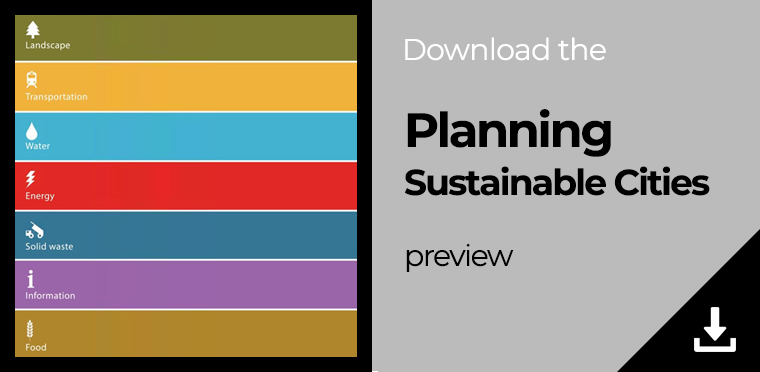Having completed the rating system for infrastructure projects, the next research effort was the Zofnass Research on the City Scale Sustainability. Zofnass sees a city as a system whose sustainability is based not only on the sustainability of individual projects (and buildings) but also on the overall planning of the entire infrastructure systems that serve the city and their own sustainability. The seven types of hard infrastructure that have been defined in the Zofnass Program are:
Click on the icons to view case studies of each type of hard infrastructure
A significant part of this research process was the interaction and elaboration of findings with experts from the leading infrastructure firms in the US. The Planning Guidelines do not prescribe specific actions to reach the sustainability objectives. They determine the direction of planning and leave specific actions open-ended. They facilitate the development of customized actions to each city’s unique context, conditions, and priorities and by promoting at the same time innovation, allowing for the incorporation of new or improved technologies as they become available.
This research fills a gap between the professions of planners and engineers, both contributing to the fundamental process of planning and building infrastructure for cities. It responds to the urgency of integrating these practices, with the objective of creating sustainable urban environments, and forms the foundation of a common collaborative platform, among public authorities, planners, and engineers, enabling those who have traditionally functioned in silos to work together in infrastructure planning.
The Planning Guidelines identify synergistic effects and inter-dependencies among the infrastructure systems, combine entities, and avoid replicated efforts and costs. They connect by-products and feedstock needs and reduce initial demand. Synergies can enable a systemic approach to financing rather than only project finance, altering perceptions of cost (e.g. multiple cross-sector revenue streams through shared problem solving). Finally, they help balance consumption and demand for infrastructure:
less demand ? less production need ? less installed capacity for infrastructure ? less cost
The research concluded with the ‘Planning Sustainable Cities’ publication in 2016, directed and edited by Prof. S.N.Pollalis.
Further resources
To order the book:
Planning Sustainable Cities: An infrastructure-based approach
Research team
Program & Research Director
Prof. Spiro Pollalis, pollalis@gsd.harvard.edu
Research Associates
Evgenia Hagistavrou
Dimosthenis Lappas
Eleonora Marinou, eleonoramarinou@gmail.com
Yannis Orfanos
Vicky Sagia
Richa S. Vuppuluri
Olga Tzioti
Harvard Faculty Advisors
Amy C. Edmondson, Harvard Business School (HBS)
Richard T.T. Forman, Harvard Graduate School of Design (GSD)
José A. Gómez-Ibáñez, Harvard Graduate School of Design (GSD)
Wendy B. Jacobs, Harvard Law School (HLS)
John D. Spengler, Harvard School of Public Health (HSPH)
Katherine E. Konschnik, Environmental Policy Initiative (HLS)
Hanif Kara, Harvard Graduate School of Design (GSD)
John Macomber, Harvard Business School (HBS)
Ali Malkawi, Harvard Graduate School of Design (GSD)
Richard Peiser, Harvard Graduate School of Design (GSD)
Daniel P. Schrag, Harvard Center for the Environment (FAS)
Industry Advisors
Douglas M. Owen, Arcadis
Terry D. Bennett, Autodesk
Erin Mosley, CH2M
Alida Saleh, EXP
Hannah Hamling, Golder
Roberto Mezzalama, Golder
Geoff Boraston, Granite Construction
Jim Grant, HNTB
Ana Maria Vidaurre, Inter-American Development Bank (IDB)
Loren A. Labovitch, MWH Global
Dickerson Wright, NV5
Laura Bonich, NV5
Stuart Lesser, NV5
Richard Corolewski, Power Engineers, Inc.
Rich Allen, Stantec Corporation
Marty Janowitz, Stantec Corporation
















